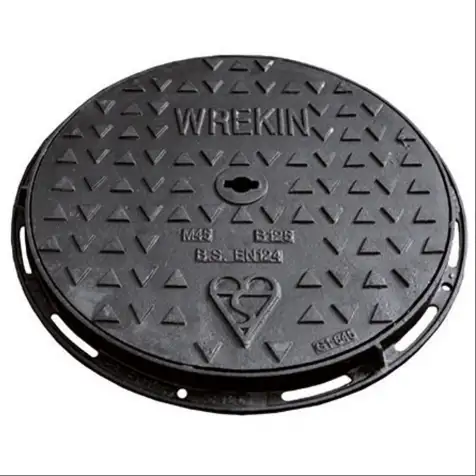Ductile iron covers and frames are essential components in urban infrastructure, providing access to underground utilities while ensuring safety and durability. Understanding the pricing of these components is crucial for municipalities, contractors, and engineers involved in infrastructure projects. This guide delves into the factors influencing the cost of ductile iron covers and frames, offering insights into material specifications, load classifications, manufacturing standards, and more.

1. Understanding Ductile Iron Covers and Frames
1.1 What is Ductile Iron?
Ductile iron, also known as nodular cast iron or spheroidal graphite iron, is a type of cast iron characterized by its high strength, ductility, and impact resistance. These properties make it ideal for manufacturing manhole covers and frames that can withstand heavy loads and harsh environmental conditions.
1.2 Importance in Infrastructure
Ductile iron covers and frames are widely used in:
-
Sewer systems
-
Stormwater management
-
Utility access points
-
Telecommunication networks
Their durability and load-bearing capacity ensure long-term performance and safety.
2. Factors Influencing Pricing
2.1 Material Costs
The price of raw materials, particularly iron ore and alloying elements, significantly impacts the cost of ductile iron products. Fluctuations in global metal markets can lead to price variations.
2.2 Manufacturing Processes
Advanced casting techniques, machining, and finishing processes contribute to the overall cost. Precision in manufacturing ensures product quality and compliance with standards.
2.3 Load Classifications
Manhole covers and frames are categorized based on their load-bearing capacity:
| Load Class | Application | Load Capacity |
|---|---|---|
| A15 | Pedestrian areas | 1.5 tons |
| B125 | Light vehicles | 12.5 tons |
| C250 | Residential roads | 25 tons |
| D400 | Main roads | 40 tons |
| E600 | Industrial areas | 60 tons |
| F900 | Airports | 90 tons |
Higher load classes require more material and robust designs, increasing costs.
2.4 Standards and Certifications
Compliance with international standards like EN 124 and ASTM A536 ensures product reliability but may add to the cost due to stringent testing and quality control measures.
2.5 Customization
Custom designs, logos, or specific dimensions tailored to client requirements can increase manufacturing complexity and cost.
3. Price Range Overview
Prices for ductile iron covers and frames vary based on size, load class, and customization. Below is a general price range:
| Size (mm) | Load Class | Price Range (USD) |
|---|---|---|
| 600×600 | C250 | $50 – $100 |
| 600×600 | D400 | $85 – $150 |
| 900×600 | D400 | $100 – $200 |
| 1000×1000 | E600 | $150 – $300 |
*Note: Prices are indicative and may vary based on market conditions and supplier.
4. Global Suppliers and Pricing
4.1 Asia
Manufacturers in China and India offer competitive pricing due to lower labor and production costs. For instance, prices can range from $20 to $100 per unit depending on specifications.
4.2 Europe
European suppliers often provide products with higher compliance standards, leading to prices ranging from $100 to $300 per unit.
4.3 North America
In the U.S., prices typically range from $125 to $297 per unit, reflecting higher manufacturing and compliance costs.
5. Cost-Saving Strategies
5.1 Bulk Purchasing
Ordering in large quantities can lead to discounts and reduced per-unit costs.
5.2 Standardization
Opting for standard sizes and designs minimizes customization costs.
5.3 Supplier Comparison
Evaluating multiple suppliers for pricing, quality, and compliance can lead to better deals.
6. Maintenance and Lifecycle Costs
While initial costs are important, considering the total cost of ownership is crucial. Ductile iron covers and frames offer long service life, reducing replacement and maintenance expenses over time.
Frequently Asked Questions (FAQs)
Q1: What factors most significantly affect the price of ductile iron covers and frames?
A1: Several factors influence the pricing of ductile iron covers and frames:
-
Material Costs: Fluctuations in the prices of raw materials like iron ore and alloying elements directly impact manufacturing costs.
-
Load Classifications: Higher load-bearing requirements necessitate more robust designs and materials, increasing costs.
-
Manufacturing Standards: Compliance with international standards such as EN 124 or ASTM A536 involves rigorous testing and quality control, adding to expenses.
-
Customization: Tailored designs, logos, or specific dimensions require additional resources and time, leading to higher prices.
-
Logistics: Transportation and shipping costs, especially for international deliveries, can significantly affect the final price.
Q2: How does load classification impact the cost of manhole covers?
A2: Load classification determines the structural requirements of a manhole cover. Higher classifications, such as D400 or E600, are designed to withstand heavier loads, requiring more material and advanced engineering. This results in increased manufacturing costs compared to lower classifications like A15 or B125, which are intended for pedestrian or light vehicular traffic.
Q3: Are there cost benefits to choosing ductile iron over other materials?
A3: Yes, ductile iron offers a favorable balance between cost and performance. Its high strength and durability lead to longer service life, reducing the need for frequent replacements. While initial costs may be higher than materials like plastic, the long-term savings in maintenance and replacement make ductile iron a cost-effective choice.
Q4: Can I get customized ductile iron covers and frames, and how does this affect pricing?
A4: Customization is available, allowing for specific dimensions, designs, or branding. However, custom orders typically involve additional design, tooling, and production processes, leading to higher costs compared to standard products. It’s essential to balance the need for customization with budget considerations.
Q5: How do international standards influence the price of ductile iron covers and frames?
A5: Adhering to international standards ensures product quality and safety but may increase costs due to the need for rigorous testing, certification, and quality assurance processes. Products meeting standards like EN 124 or ASTM A536 may be priced higher but offer assurance of performance and compliance, which can be critical for certain projects.

